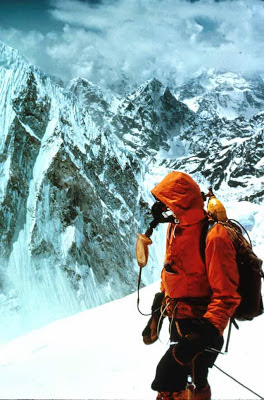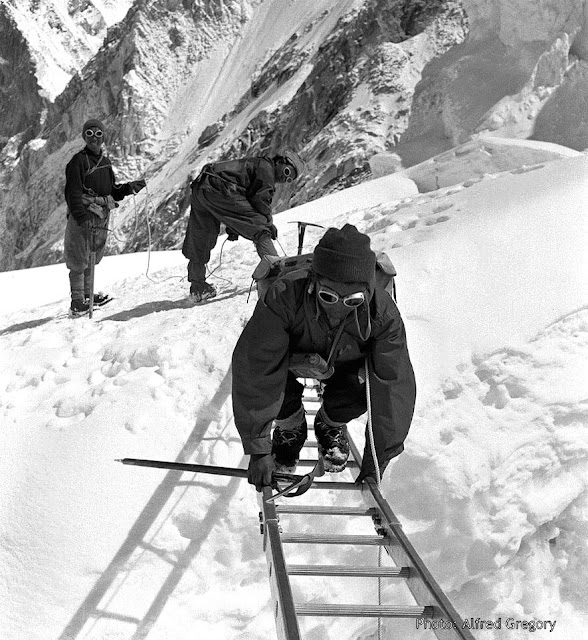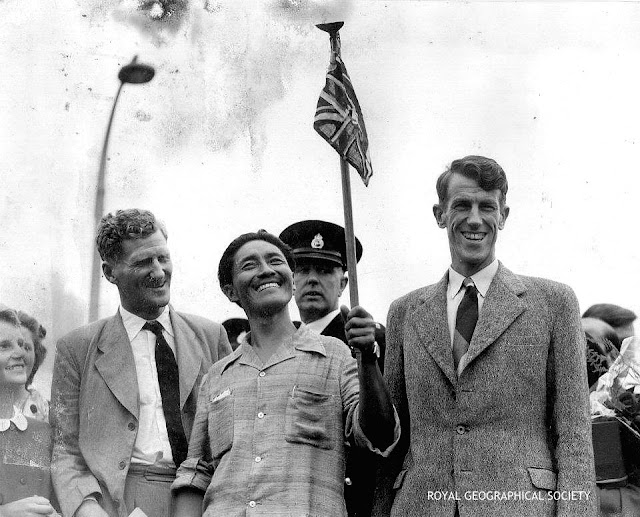Today is the 56th anniversary of the first ascent of the West ridge of Everest and the first traverse of the mountain.
On 21
st May 1963 at six o’clock in the evening two climbers reached 27,205 feet (8300 metres) to set up
Camp 5W on the west ridge of Everest. Tom Horbein a US anesthesiologist then 32 years old and Willi Unsoeld , a mountain guide then 36 years of age were poised for the final push to the summit of Everest by a new route.
It had not been easy for these two men. The 1963 American Everest Expedition led by Norman Dyhrenfurth had squarely set its sights on a first American ascent by the South Col route. On May 1st 1963, Jim Whittaker accompanied by Sherpa Nawang Gombu, Tenzing’s nephew, made the first American ascent to become the fifth and six men to stand of the summit after the British in 1953 and Swiss in 1954.
But Horbein and Unsoeld had other ideas. Working doggedly with the meager resources including limited oxygen the duo set up camps on the virgin west ridge route.
On the day of their summit climb, Barry Bishop, a National Geographic photographer, and Lute Jerstad were also attempting the summit by the South Col route. Bishop and Jerstad reached the summit around 4 pm but did not find any evidence of the west ridge team who were still two hours below the top.
 |
| Horbein on the West Ridge- Photo Courtesy Willi Unsoeld |
The West ridge pair reached the summit at 6.15 pm on 22nd May 1963 and became the 11th and 12th men to climb Everest and the fifth and sixth of their expedition. But in the context of the history of Everest it was an enormous “first”: a climb by the West Ridge for the first time and more was to follow. They had been climbing for more than eleven hours since dawn. They saw the boot prints of Whittaker and Gombu and fresh prints which they knew must be of Bishop and Jerstad.
Maynard Miller and Jimmy Roberts at Advance Base (around 23,500 feet) below had scanned the heights throughout the day and kept the radio open. Around 7 pm when it was almost dark and anxiety had risen, Willi Unsoeld’s voice came through the radio. They had just summitted Everest he said and were descending by the south east ridge in the dark on a route known to neither.
“Roger, Roger” Maynad called back through the crackle and wind.
And then he heard Willi’s voice again faint and indistinct reciting:
“…. I have promises to keep,
And miles to go before we sleep,
And miles to go before we sleep….”
The “promises” were to Willi’s wife Joelene that Everest would be his last big mountain.
The west ridgers left the summit around two hours behind the south col team. With a flickering flashlight whose batteries were fast waning, the two climbers descended, following the boot prints and ice axe marks of Jerstad and Bishop. But soon the last light faded from the sky and night descended on the slopes of Everest. The climbers reduced the 150 feet rope into half so that they could remain closer to each other.
Jerstad and Bishop’s descent of the south east ridge earlier was also not without drama. The seventy mile gusts were dragging the climbers towards the edge of the ridge and in Bishop’s words “ A section of the cornice at my chest gave way and I had a sudden hair raising view of the Kangshung glacier 10,000 feet below”. Bishop unroped himself and managed to return to the trail.
Suddenly they began to hear voices in the wilderness “Helloo, Helloo” and thought it was a rescue party from Camp VI coming up in searching for them. Then they realized that the voices were from above. The West ridge climbers had descended in record time and caught up with the South Col team!
The four climbers then descended together down the south east ridge. The torch which Unsoeld had finally gave way and in the glimmer of starlight the climbers stumbled down. Finally at 12.30 midnight it was not possible to continue any further and the four Everesters sat down for what would be the highest bivouac at that time.
In 1953 Herman Buhl on his descent from Nanga Parbat and in 1955 Walter Bonatti and his porter had also spent the night at around 26,000 feet on K2 and survived though not without loss.
But the bivouac of the Americans was around 28,000 feet. However, luck was on their side. It was one night in fifty that the jet stream winds were silent on Everest!
In Everest- The West Ridge, Horbein wrote:
"The night was overpoweringly empty. Stars shed cold, unshimmering light. The heat lightning dancing along the plains spoke of a world of warmth and flatness. The black silhouette of Lhotse lurked half-sensed, half-seen, still below. Only the ridge we were on rose higher, disappearing into the night, a last lonely outpost of the world."
 |
Climbers on the West Ridge of Everest Photo:
Barry Bishop from Everest The West Ridge |
Amazingly, despite all odds the climbers survived to greet the icy dawn. National Geographic photographer Barry Bishop writes that it was one of finest mornings he had ever seen but he and his camera was too frozen to take a single photograph.
But the bivouac took a heavy toll. Unsoeld lost nine toes to frostbite and Bishop six. Jerstad and Horbein were extremely lucky to get away unscathed.
Since the first West Ridge climb in 1963, there have been about sixty attempts on the route with about half a dozen successful climbs including the West Ridge direct. The number of deaths and the number of summiteers on this route have been about the same making it one of the hardest routes on Everest.
In 2012 two teams from the USA including crack climbers like Conrad Anker, Cory Richards, Jake Norton and David Morton attempted the west ridge to commemorate the 1963 expedition. Unfavourable conditions forced both teams to give up the west ridge route.
In 1979 Unsoeld died on an avalanche on Mount Rainier - one of the peaks he used to guide. Horbein recollects that Unsoeld and he spoke each year on May 22nd, the anniversary of their west ridge climb. After Unsoeld’s death Horbein speaks to his widow Jolene on that day.
In the end, expedition leader Norman Dyhrenfurth, though pushing for the South Col ascent gave the west ridge team full credit. Dyhrenfurth said “For years it had been the dream of mountaineers to do a major Himalayan traverse. We were particularly happy and proud that this was not only the first Himalayan traverse but that it was on Everest.”


















